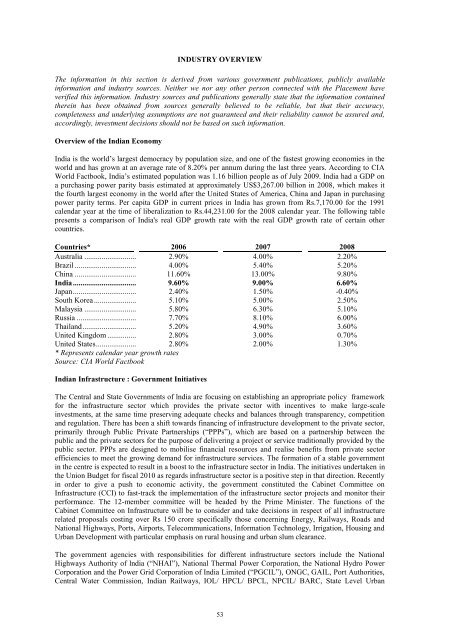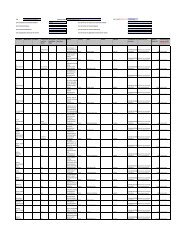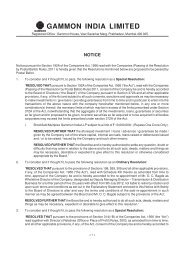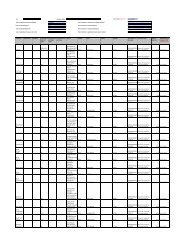GAMMON INDIA LIMITED
GAMMON INDIA LIMITED
GAMMON INDIA LIMITED
You also want an ePaper? Increase the reach of your titles
YUMPU automatically turns print PDFs into web optimized ePapers that Google loves.
INDUSTRY OVERVIEW<br />
The information in this section is derived from various government publications, publicly available<br />
information and industry sources. Neither we nor any other person connected with the Placement have<br />
verified this information. Industry sources and publications generally state that the information contained<br />
therein has been obtained from sources generally believed to be reliable, but that their accuracy,<br />
completeness and underlying assumptions are not guaranteed and their reliability cannot be assured and,<br />
accordingly, investment decisions should not be based on such information.<br />
Overview of the Indian Economy<br />
India is the world‘s largest democracy by population size, and one of the fastest growing economies in the<br />
world and has grown at an average rate of 8.20% per annum during the last three years. According to CIA<br />
World Factbook, India‘s estimated population was 1.16 billion people as of July 2009. India had a GDP on<br />
a purchasing power parity basis estimated at approximately US$3,267.00 billion in 2008, which makes it<br />
the fourth largest economy in the world after the United States of America, China and Japan in purchasing<br />
power parity terms. Per capita GDP in current prices in India has grown from Rs.7,170.00 for the 1991<br />
calendar year at the time of liberalization to Rs.44,231.00 for the 2008 calendar year. The following table<br />
presents a comparison of India's real GDP growth rate with the real GDP growth rate of certain other<br />
countries.<br />
Countries* 2006 2007 2008<br />
Australia ........................... 2.90% 4.00% 2.20%<br />
Brazil ................................ 4.00% 5.40% 5.20%<br />
China ................................ 11.60% 13.00% 9.80%<br />
India ................................. 9.60% 9.00% 6.60%<br />
Japan ................................. 2.40% 1.50% -0.40%<br />
South Korea ...................... 5.10% 5.00% 2.50%<br />
Malaysia ........................... 5.80% 6.30% 5.10%<br />
Russia ............................... 7.70% 8.10% 6.00%<br />
Thailand ............................ 5.20% 4.90% 3.60%<br />
United Kingdom ............... 2.80% 3.00% 0.70%<br />
United States ..................... 2.80% 2.00% 1.30%<br />
* Represents calendar year growth rates<br />
Source: CIA World Factbook<br />
Indian Infrastructure : Government Initiatives<br />
The Central and State Governments of lndia are focusing on establishing an appropriate policy framework<br />
for the infrastructure sector which provides the private sector with incentives to make large-scale<br />
investments, at the same time preserving adequate checks and balances through transparency, competition<br />
and regulation. There has been a shift towards financing of infrastructure development to the private sector,<br />
primarily through Public Private Partnerships (―PPPs‖), which are based on a partnership between the<br />
public and the private sectors for the purpose of delivering a project or service traditionally provided by the<br />
public sector. PPPs are designed to mobilise financial resources and realise benefits from private sector<br />
efficiencies to meet the growing demand for infrastructure services. The formation of a stable government<br />
in the centre is expected to result in a boost to the infrastructure sector in India. The initiatives undertaken in<br />
the Union Budget for fiscal 2010 as regards infrastructure sector is a positive step in that direction. Recently<br />
in order to give a push to economic activity, the government constituted the Cabinet Committee on<br />
Infrastructure (CCI) to fast-track the implementation of the infrastructure sector projects and monitor their<br />
performance. The 12-member committee will be headed by the Prime Minister. The functions of the<br />
Cabinet Committee on Infrastructure will be to consider and take decisions in respect of all infrastructure<br />
related proposals costing over Rs 150 crore specifically those concerning Energy, Railways, Roads and<br />
National Highways, Ports, Airports, Telecommunications, Information Technology, Irrigation, Housing and<br />
Urban Development with particular emphasis on rural housing and urban slum clearance.<br />
The government agencies with responsibilities for different infrastructure sectors include the National<br />
Highways Authority of lndia (―NHAI‖), National Thermal Power Corporation, the National Hydro Power<br />
Corporation and the Power Grid Corporation of India Limited (―PGCIL‖), ONGC, GAIL, Port Authorities,<br />
Central Water Commission, Indian Railways, IOL/ HPCL/ BPCL, NPCIL/ BARC, State Level Urban<br />
53
















